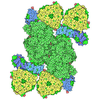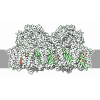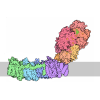[English] 日本語
 Yorodumi
Yorodumi- PDB-7o01: Dimeric Photosystem I of a temperature sensitive mutant Chlamydom... -
+ Open data
Open data
- Basic information
Basic information
| Entry | Database: PDB / ID: 7o01 | |||||||||
|---|---|---|---|---|---|---|---|---|---|---|
| Title | Dimeric Photosystem I of a temperature sensitive mutant Chlamydomonas reinhardtii | |||||||||
 Components Components |
| |||||||||
 Keywords Keywords | PHOTOSYNTHESIS / chlamydomonas / photosystem I / temperature sensitive / water molecules | |||||||||
| Function / homology |  Function and homology information Function and homology informationphotosynthesis, light harvesting in photosystem I / photosynthesis, light harvesting / chloroplast thylakoid lumen / photosystem I reaction center / photosystem I / photosynthetic electron transport in photosystem I / photosystem I / photosystem II / chlorophyll binding / chloroplast thylakoid membrane ...photosynthesis, light harvesting in photosystem I / photosynthesis, light harvesting / chloroplast thylakoid lumen / photosystem I reaction center / photosystem I / photosynthetic electron transport in photosystem I / photosystem I / photosystem II / chlorophyll binding / chloroplast thylakoid membrane / response to light stimulus / photosynthesis / 4 iron, 4 sulfur cluster binding / oxidoreductase activity / electron transfer activity / magnesium ion binding / metal ion binding Similarity search - Function | |||||||||
| Biological species |  | |||||||||
| Method | ELECTRON MICROSCOPY / single particle reconstruction / cryo EM / Resolution: 17.1 Å | |||||||||
 Authors Authors | Caspy, I. / Nelson, N. | |||||||||
| Funding support |  Israel, 2items Israel, 2items
| |||||||||
 Citation Citation |  Journal: Commun Biol / Year: 2021 Journal: Commun Biol / Year: 2021Title: Dimeric and high-resolution structures of Chlamydomonas Photosystem I from a temperature-sensitive Photosystem II mutant. Authors: Ido Caspy / Tom Schwartz / Vinzenz Bayro-Kaiser / Mariia Fadeeva / Amit Kessel / Nir Ben-Tal / Nathan Nelson /  Abstract: Water molecules play a pivotal functional role in photosynthesis, primarily as the substrate for Photosystem II (PSII). However, their importance and contribution to Photosystem I (PSI) activity ...Water molecules play a pivotal functional role in photosynthesis, primarily as the substrate for Photosystem II (PSII). However, their importance and contribution to Photosystem I (PSI) activity remains obscure. Using a high-resolution cryogenic electron microscopy (cryo-EM) PSI structure from a Chlamydomonas reinhardtii temperature-sensitive photoautotrophic PSII mutant (TSP4), a conserved network of water molecules - dating back to cyanobacteria - was uncovered, mainly in the vicinity of the electron transport chain (ETC). The high-resolution structure illustrated that the water molecules served as a ligand in every chlorophyll that was missing a fifth magnesium coordination in the PSI core and in the light-harvesting complexes (LHC). The asymmetric distribution of the water molecules near the ETC branches modulated their electrostatic landscape, distinctly in the space between the quinones and FX. The data also disclosed the first observation of eukaryotic PSI oligomerisation through a low-resolution PSI dimer that was comprised of PSI-10LHC and PSI-8LHC. | |||||||||
| History |
|
- Structure visualization
Structure visualization
| Movie |
 Movie viewer Movie viewer |
|---|---|
| Structure viewer | Molecule:  Molmil Molmil Jmol/JSmol Jmol/JSmol |
- Downloads & links
Downloads & links
- Download
Download
| PDBx/mmCIF format |  7o01.cif.gz 7o01.cif.gz | 1.4 MB | Display |  PDBx/mmCIF format PDBx/mmCIF format |
|---|---|---|---|---|
| PDB format |  pdb7o01.ent.gz pdb7o01.ent.gz | 1.1 MB | Display |  PDB format PDB format |
| PDBx/mmJSON format |  7o01.json.gz 7o01.json.gz | Tree view |  PDBx/mmJSON format PDBx/mmJSON format | |
| Others |  Other downloads Other downloads |
-Validation report
| Summary document |  7o01_validation.pdf.gz 7o01_validation.pdf.gz | 1.1 MB | Display |  wwPDB validaton report wwPDB validaton report |
|---|---|---|---|---|
| Full document |  7o01_full_validation.pdf.gz 7o01_full_validation.pdf.gz | 1.1 MB | Display | |
| Data in XML |  7o01_validation.xml.gz 7o01_validation.xml.gz | 171.2 KB | Display | |
| Data in CIF |  7o01_validation.cif.gz 7o01_validation.cif.gz | 288.3 KB | Display | |
| Arichive directory |  https://data.pdbj.org/pub/pdb/validation_reports/o0/7o01 https://data.pdbj.org/pub/pdb/validation_reports/o0/7o01 ftp://data.pdbj.org/pub/pdb/validation_reports/o0/7o01 ftp://data.pdbj.org/pub/pdb/validation_reports/o0/7o01 | HTTPS FTP |
-Related structure data
| Related structure data |  12672MC  7bgiC  7blxC M: map data used to model this data C: citing same article ( |
|---|---|
| Similar structure data |
- Links
Links
- Assembly
Assembly
| Deposited unit | 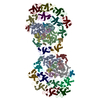
|
|---|---|
| 1 |
|
- Components
Components
-Photosystem I P700 chlorophyll a apoprotein ... , 2 types, 4 molecules AaBb
| #1: Protein | Mass: 82121.938 Da / Num. of mol.: 2 / Source method: isolated from a natural source / Source: (natural)  #2: Protein | Mass: 81996.016 Da / Num. of mol.: 2 / Source method: isolated from a natural source / Source: (natural)  |
|---|
-Protein , 2 types, 4 molecules CcLl
| #3: Protein | Mass: 8738.130 Da / Num. of mol.: 2 / Source method: isolated from a natural source / Source: (natural)  #11: Protein | Mass: 14130.248 Da / Num. of mol.: 2 / Source method: isolated from a natural source / Source: (natural)  |
|---|
-Photosystem I reaction center subunit ... , 7 types, 14 molecules DdEeFfGgIiJjKk
| #4: Protein | Mass: 16152.684 Da / Num. of mol.: 2 / Source method: isolated from a natural source / Source: (natural)  #5: Protein | Mass: 7021.877 Da / Num. of mol.: 2 / Source method: isolated from a natural source / Source: (natural)  #6: Protein | Mass: 17957.773 Da / Num. of mol.: 2 / Source method: isolated from a natural source / Source: (natural)  #7: Protein | Mass: 9572.677 Da / Num. of mol.: 2 / Source method: isolated from a natural source / Source: (natural)  #8: Protein/peptide | Mass: 3970.731 Da / Num. of mol.: 2 / Source method: isolated from a natural source / Source: (natural)  #9: Protein/peptide | Mass: 4516.257 Da / Num. of mol.: 2 / Source method: isolated from a natural source / Source: (natural)  #10: Protein | Mass: 8146.467 Da / Num. of mol.: 2 / Source method: isolated from a natural source / Source: (natural)  |
|---|
-Chlorophyll a-b binding protein, ... , 9 types, 18 molecules 1Zpz3q7r8s4t5u6v29
| #12: Protein | Mass: 20368.023 Da / Num. of mol.: 4 / Source method: isolated from a natural source / Source: (natural)  #13: Protein | Mass: 23689.025 Da / Num. of mol.: 2 / Source method: isolated from a natural source / Source: (natural)  #14: Protein | Mass: 23304.396 Da / Num. of mol.: 2 / Source method: isolated from a natural source / Source: (natural)  #15: Protein | Mass: 23293.613 Da / Num. of mol.: 2 / Source method: isolated from a natural source / Source: (natural)  #16: Protein | Mass: 23018.188 Da / Num. of mol.: 2 / Source method: isolated from a natural source / Source: (natural)  #17: Protein | Mass: 25122.805 Da / Num. of mol.: 2 / Source method: isolated from a natural source / Source: (natural)  #18: Protein | Mass: 24937.922 Da / Num. of mol.: 2 / Source method: isolated from a natural source / Source: (natural)  #19: Protein | | Mass: 21658.100 Da / Num. of mol.: 1 / Source method: isolated from a natural source / Source: (natural)  #20: Protein | | Mass: 19929.818 Da / Num. of mol.: 1 / Source method: isolated from a natural source / Source: (natural)  |
|---|
-Details
| Has ligand of interest | N |
|---|---|
| Has protein modification | Y |
-Experimental details
-Experiment
| Experiment | Method: ELECTRON MICROSCOPY |
|---|---|
| EM experiment | Aggregation state: PARTICLE / 3D reconstruction method: single particle reconstruction |
- Sample preparation
Sample preparation
| Component | Name: Photosystem I of temperature sensitive Chlamydomonas reinhardtii Type: COMPLEX / Entity ID: all / Source: NATURAL |
|---|---|
| Molecular weight | Value: 0.89 MDa / Experimental value: NO |
| Source (natural) | Organism:  |
| Buffer solution | pH: 8 |
| Specimen | Embedding applied: NO / Shadowing applied: NO / Staining applied: NO / Vitrification applied: YES |
| Vitrification | Cryogen name: ETHANE |
- Electron microscopy imaging
Electron microscopy imaging
| Experimental equipment |  Model: Titan Krios / Image courtesy: FEI Company |
|---|---|
| Microscopy | Model: FEI TITAN KRIOS |
| Electron gun | Electron source:  FIELD EMISSION GUN / Accelerating voltage: 300 kV / Illumination mode: FLOOD BEAM FIELD EMISSION GUN / Accelerating voltage: 300 kV / Illumination mode: FLOOD BEAM |
| Electron lens | Mode: BRIGHT FIELD / Nominal magnification: 165000 X |
| Specimen holder | Cryogen: NITROGEN |
| Image recording | Electron dose: 46.8 e/Å2 / Film or detector model: GATAN K3 BIOQUANTUM (6k x 4k) / Num. of real images: 12418 |
- Processing
Processing
| Software |
| ||||||||||||||||||||||||||||||||||||||||
|---|---|---|---|---|---|---|---|---|---|---|---|---|---|---|---|---|---|---|---|---|---|---|---|---|---|---|---|---|---|---|---|---|---|---|---|---|---|---|---|---|---|
| EM software |
| ||||||||||||||||||||||||||||||||||||||||
| CTF correction | Type: NONE | ||||||||||||||||||||||||||||||||||||||||
| Particle selection | Num. of particles selected: 1208518 | ||||||||||||||||||||||||||||||||||||||||
| 3D reconstruction | Resolution: 17.1 Å / Resolution method: FSC 0.143 CUT-OFF / Num. of particles: 5707 / Symmetry type: POINT | ||||||||||||||||||||||||||||||||||||||||
| Atomic model building | Protocol: RIGID BODY FIT / Space: REAL | ||||||||||||||||||||||||||||||||||||||||
| Atomic model building | PDB-ID: 6JO5 Accession code: 6JO5 / Source name: PDB / Type: experimental model | ||||||||||||||||||||||||||||||||||||||||
| Refinement | Cross valid method: NONE Stereochemistry target values: GeoStd + Monomer Library + CDL v1.2 | ||||||||||||||||||||||||||||||||||||||||
| Displacement parameters | Biso mean: 999.99 Å2 | ||||||||||||||||||||||||||||||||||||||||
| Refine LS restraints |
|
 Movie
Movie Controller
Controller







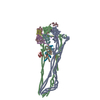


 PDBj
PDBj